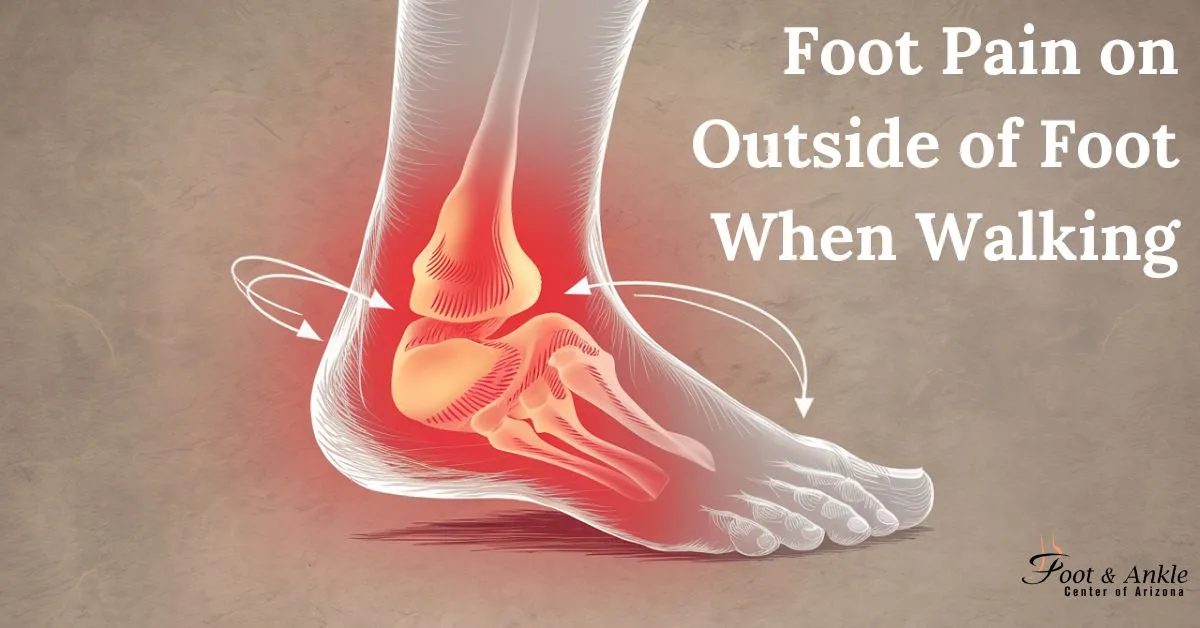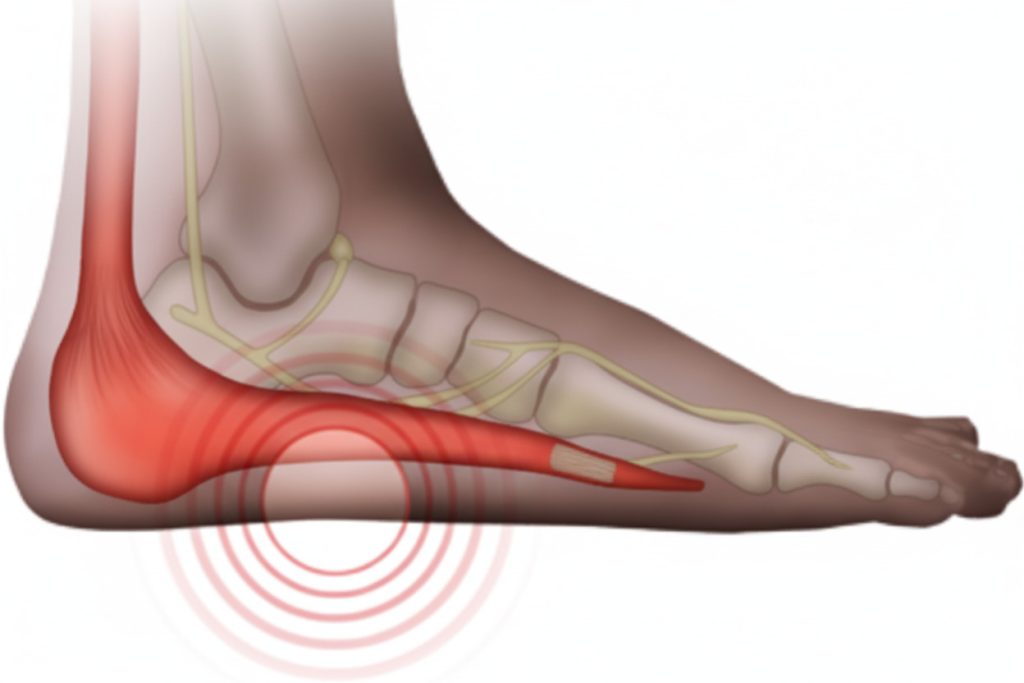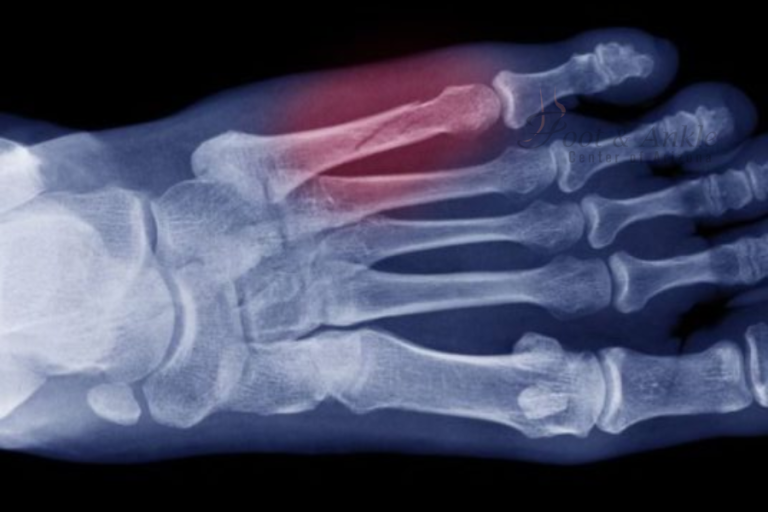Lateral Foot Pain: Causes, Symptoms & Treatment
Are you experiencing pain on the side of your foot? It is actually very common. Luckily, once properly diagnosed with lateral foot pain, there are ways to treat it, even in the comfort of your own home.
What is Lateral Foot Pain?
Lateral foot pain is pain on the outer side of the foot. This is oftentimes tied to cuboid syndrome, which is when the bone on the outside of the foot shifts out of place. Torn joints and ligaments typically cause the bone to shift. This can happen over time or suddenly due to an ankle sprain. Quality treatment is needed for relief.
Causes of Lateral Foot Pain
There are a few different causes of lateral foot pain such as injury to the area of the foot, an ankle sprain, or excessive traction on the bone. Also, repetitive activities such as running and jumping can cause lateral foot pain. This is why ballet dancers, runners, and athletes experience lateral foot pain often. People with flat feet also tend to suffer more with pain on the side of their foot.
Symptoms of Lateral Foot Pain
The first sign of lateral foot pain is pain on the side of the foot extending from the ankle to the toes. Lateral foot pain can also cause a limp. Tenderness, swelling, difficulty walking, and putting pressure on your foot can also be symptoms of lateral foot pain.
Diagnosis Lateral Foot Pain by a Foot Doctor in Scottsdale
Diagnosing lateral foot pain isn’t always easy. A foot doctor in Scottsdale, AZ can examine to foot, and swelling of the cuboid bone is usually a tell-tale sign.
However, for a more accurate diagnosis from your podiatrist, an MRI, CT scan, or X-ray may be needed.
Treatment for Lateral Foot Pain Approved by a Scottsdale Foot Doctor
The treatment plan for lateral foot pain depends on the severity of the pain. Usually, ice, plenty of rest, custom foot orthotics, a brace, and certain exercises can help with lateral foot pain. Elevation helps with the swelling and compression with an elastic bandage can also be helpful. In more extreme cases, other treatment options such as surgery are needed.
Before starting any exercises, always consult with a podiatrist for approval. Also, some home stretches can be done to help relieve the pain.
It takes time to strengthen your foot and ankle, so always listen to your body. Start by gently massaging your foot for relief. For a nice stretch, sit in a chair and gently pull your toes upward towards the ankle. This should help loosen any extra tension in the area.
Top Foot Doctor in Scottsdale
The Foot and Ankle Center of Arizona offers specialized care and treatment options for all types of foot and ankle pain, including lateral foot pain. After receiving the best possible care at the Foot and Ankle Center of Arizona, you will receive a comprehensive treatment plan to get you on the road to recovery.
More additional information about foot pain
Anatomy of the Outer Foot:
Lateral foot pain can originate from several structural elements that work together to provide support, flexibility, and movement within the foot. These include bones, tendons, ligaments, and joints. Knowing the anatomy of the outer side of the foot explains possible causes of lateral leg pain and suggests appropriate treatment. This article describes the major bones, tendons, and ligaments along with the nerves involved in the lateral part of the foot and their functions to the general function of the foot.
Bones Involved in the Outer Foot
The bones in the lateral part of the foot are important in terms of balance and weight distribution, which is crucial during walking or running. The key bones related to the outer foot are as follows:
1. Fifth Metatarsal
- Location: This is the long bone on the outside of the foot, extending from the base of the pinky toe to the midfoot area.
- Function: It plays a very significant role in weight-bearing and balance, most especially in pushing outward, or being able to propel one’s self from the ground.
- Fractures and Other Associated Problems: The fifth metatarsal remains very prone to overuse fractures and contusions. The most common stress fracture occurs in the neck of the bone and among athletes or individuals in high-impact activities.
2. Cuboid Bone
- Location: In the midfoot, the cuboid is a cube-shaped bone that connects the heel bone – calcaneus with the fourth and fifth metatarsals.
- Function: Stabilizes the lateral aspect of the foot forming part of the arch and contributing to lateral stability during locomotion.
- Associated Issues: Cuboid syndrome, or misalignment of the cuboid bone, may result in sharp, localized pain on the outside of the foot. This usually occurs from ankle sprains or overuse.
3. Calcaneus (Heel Bone)
- Location: It is the largest bone of the foot, positioned at the back of the heel, and forms the base of the lateral foot.
- Function: It serves to absorb the shock during walking, support the arch, and in close coordination with other bones, facilitate various movements and weight transmission.
- Associated Issues: These are calcaneal fractures and stress injuries that may eventually cause heel pain, radiating to the lateral side of the usually after repeated impact or acute trauma.
Tendons and Ligaments Supporting the Outer Foot
The tendons and ligaments in the outer foot are very important in the stabilization and support of movements of the foot. These either connect bones together or to muscles and thus provide for smooth movement and the weight-bearing functions of the foot.
Peroneal Tendons
- Location: The peroneal tendons are located on the outer side of the foot and ankle and weave the peroneal muscles of the lower leg into the bones of the feet.
- Function: They provide lateral stability, especially in conditions of uneven walking or running, and help prevent ankle rolling.
- Associated Issues: The two most common causes of peroneal tendonitis-overuse and repetitive stress-can result in inflammation of these tendons, leading to painful swelling along the outside of the foot. Injuries to the peroneal tendons are common in athletes, particularly those who take part in high-impact sports.
Plantar Fascia
- Location: This thick band of tissue runs from the heel to the toes, primarily on the bottom of the foot but also supporting the outer side.
- Function: Plantar fascia supports the arch and absorbs impact during weight-bearing function.
- Associated Issues: While plantar fasciitis is more commonly thought of in heel/arch pain, the plantar fascia may be part of lateral foot pain, especially with structural issues such as high arches.
Lateral Ligaments
- Location: Various ligaments connect bones along the outer edge of the foot and ankle including the anterior talofibular ligament, calcaneofibular ligament, and posterior talofibular ligament.
- Function: The ligaments have the role of supporting the ankle joint, preventing excessive sideways movements.
- Related Problems: Sprains of the ankle are usually caused by over-stretching or tearing of these ligaments, which leads to pain in the lateral aspect of the foot, swelling, and instability.
Joints and Nerves in the Outer Foot
The lateral part of the foot is enabled with various joints that provide movement and flexibility, while nerves help in conducting signals which contribute to pain sensation and overall functioning of the foot. Following are some of the key joints and nerves involved:
Cuboid-Metatarsal Joint
- Anatomical location: This is the joint between the cuboid bone and the fourth and fifth metatarsal bones.
- Function: It allows the balance between flexion and extension that provides the gait with stability, contributing to lateral foot stability.
- Associated Issues: Diseases of the cuboid syndrome or arthritis of the cuboid-metatarsal joint may associate with restricted mobility and weight-bearing pain on the lateral aspect of the foot.
Calcaneocuboid Joint
- Location: This joint is between the calcaneus (heel bone) and the cuboid bone.
- Function: It allows for the subtler rotations of the foot that increase stability and allow even distribution of weight across the outer edge of the foot.
- Associated Issues: Arthritis, misalignment, or sprain in this joint gives rise to pain and stiffness laterally in the foot, which affects the comfortability with which a person can walk.
Sural Nerve
- Location: First of all, the sural nerve runs down the outer aspect of the foot from the calf to the ankle to the outer edge of the foot.
- Function: It provides sensation to the skin along the outer foot and ankle.
- Associated Disorders: Irritation or mechanical compression of the sural nerve may manifest as numbness, tingling, or sharp pain along the outer foot. Pain of this nature is usually neurological in origin rather than structural and may be accentuated by extended walking or standing.
Pain on Outside of Foot When Walking
Lateral foot pain is a common issue for people who walk, run, or have to stand for long periods of time. Pain on the outside of the foot can vary from mild discomfort to sharp and debilitating. This can be extremely debilitating, and understanding the causes and how to address the pain effectively is crucial for the relief and prevention of long-term problems.

Common Causes of Pain on the Outside of the Foot While Walking
Several conditions can lead to lateral foot pain, each with its unique characteristics and treatment needs:
Peroneal Tendinitis
Peroneal tendinitis involves the inflammation of the tendons along the outer ankle and foot. These tendons supply stability to the foot, with overuse from walking or standing being capable of irritating these tissues. Pain and swelling that is exacerbated by movement commonly result.
Stress Fractures
Stress fractures are small breaks in the bone from chronic force; they are common in persons who walk or run a lot. They classically present with pinpoint pain that is worse with activity. The stress fractures of the fifth metatarsal, or the bone of the lateral foot, are commonly seen in lateral foot pain.
Cuboid Syndrome
The cuboid syndrome type is a slight misalignment of the cuboid bone—usually due to trauma to the ankle or repeated stress. It causes a sharp, sharp pain on the outside of the leg, which may worsen with walking or weight bearing. Ankle sprains cause discomfort on the outside of the foot. Even a minor sprain can cause chronic pain deep in the foot, especially after a long walk.
Arthritis and Joint Problems
The joints of the foot can show arthritis, especially in older people or those who have had previous foot injuries. Pain associated with arthritis is usually accompanied by stiffness and swelling and is typically worse after activity.
Foot Structure and Gait Abnormalities
Individuals with high arches or those with flat feet will expose the outside of their feet to additional pressure while walking. This could be because of a structural imbalance that pulls on the lateral side; at times, it may create pain over time.
Symptoms of Lateral Foot Pain When Walking
Pain on the outside of the foot when walking can manifest in several ways, depending on the underlying cause:
- Types of Pain: These include pain ranging from sharp and stabbing to dull and aching.
- Location: More often than not, on the outer heel, pinky toe, or around the ankle.
- Additional Symptoms: Swelling, tenderness, warmth, and occasional bruising.
- Changes in Gait: Favoring one’s gait or limping to prevent the diseased limb from bearing weight.
Risk Factors for Developing Outer Foot Pain While Walking
Certain risk factors can make someone more susceptible to experiencing lateral foot pain:
- High-impact Activities: High-impact activities like walking, running, or jumping can certainly make for increased stress on the outside of the foot.
- Anatomy of the Foot: A high-arched individual, a person with flat feet, or anyone who has an abnormal gait will be more apt to have pain in the lateral foot.
- Footwear: Wearing unsupportive shoes is also a cause of misalignment of the outer foot and strain.
- Previous Injuries: Individuals who have had ankle sprains or fractures in the past are more vulnerable to lateral foot pain because of residual weakness.
How to Diagnose Pain on the Outside of the Foot When Walking
A professional diagnosis is important to determine the cause of lateral foot pain. Diagnostic approaches may include:
Physical Examination
During an initial evaluation, a healthcare provider will examine the foot’s movement, alignment, and areas of tenderness.
Imaging Tests
- X-rays can reveal fractures or alignment issues.
- MRI or CT scans provide a detailed look at soft tissues, including tendons and ligaments, which can show signs of tendonitis or ligament damage.
Gait Analysis
A gait analysis is often performed to identify abnormal walking patterns that may contribute to lateral foot pain.
Self-Care Tips for Immediate Relief
For immediate relief, self-care techniques can help manage symptoms and prevent further discomfort:
Rest and Limit Walking
Reducing physical activity can help the affected area recover. Avoiding prolonged standing or walking is recommended.
Ice Therapy
Applying ice can reduce inflammation and alleviate pain. Use an ice pack for 15-20 minutes, several times a day.
Elevation
Elevating the foot above heart level can help decrease swelling, particularly after long periods of walking or standing.
Use of Supportive Shoes and Inserts
Wearing shoes with proper support and cushioning helps redistribute pressure and align the foot properly, reducing strain on the outer side.
Treatment Options for Pain on the Outside of the Foot
If self-care doesn’t provide enough relief, a healthcare provider can recommend additional treatments:
Orthotics and Supportive Devices
Custom orthotics or lateral heel wedges can provide targeted support for foot alignment, reducing stress on the outer foot.
Physical Therapy
Exercises designed to strengthen the muscles in the foot and ankle improve stability and support. Balance training may also help correct gait issues.
Medication
Nonsteroidal anti-inflammatory drugs (NSAIDs) can help reduce inflammation and pain, especially during acute flare-ups.
Corticosteroid Injections
For chronic pain cases, corticosteroid injections may provide significant relief by reducing inflammation in the affected area.
Surgical Intervention
In severe cases, such as ongoing pain from structural misalignments or chronic tendonitis, surgery may be necessary. This option is typically reserved for patients who do not respond to conservative treatment.
The most common FAQs
Why does my foot hurt on the outside when I walk?
Lateral foot pain may be caused by conditions like peroneal tendonitis, stress fractures, or improper footwear.
Can walking too much cause lateral foot pain?
Yes, repetitive walking or high-impact activities can strain the outer side of the foot, leading to pain.
What kind of shoes should I wear to prevent lateral foot pain?
Shoes with adequate arch support, cushioning, and proper fit can help reduce strain on the lateral foot.
How long does it take to recover from pain on the outside of the foot?
Recovery time varies depending on the cause and treatment but typically takes a few weeks to several months with proper care.
Is it safe to keep walking if I have pain on the outside of my foot?
If pain persists or worsens, it’s advisable to rest and consult a healthcare provider for appropriate treatment.
What’s the most common cause of lateral foot pain?
The most common cause of lateral foot pain is peroneal tendonitis, which is often due to overuse or repetitive strain on the outer foot tendons, especially in activities that involve running, jumping, or sudden directional changes.
Can lateral foot pain resolve with home remedies alone?
Yes, mild cases of lateral foot pain can improve with rest, ice, compression, and elevation (RICE). Stretching, avoiding activities that strain the foot, and wearing supportive footwear may also help. However, if pain persists, medical attention is recommended.
What type of footwear is best to prevent lateral foot pain?
Footwear with good arch support, a cushioned sole, and a stable, firm heel counter is best for preventing lateral foot pain. Shoes that provide shock absorption and lateral support can reduce strain on the outer foot.
Is it safe to exercise with lateral foot pain?
It’s best to avoid high-impact activities if you have lateral foot pain. Light, low-impact exercises, like swimming or cycling, may be safe, but consult a healthcare professional to prevent further injury.
How long does recovery from lateral foot pain typically take?
Recovery time varies based on the severity of the pain and treatment methods. Mild cases may improve within a few days to weeks, while more severe injuries can take several weeks to a few months to heal fully.




